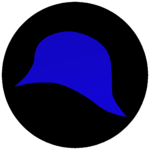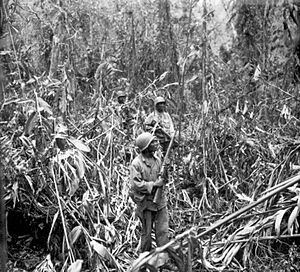93rd Infantry Division (United States) facts for kids
Quick facts for kids 93rd Division93rd Infantry Division (Colored) |
|
|---|---|

93rd Infantry Division shoulder sleeve insignia
|
|
| Active | 1917–1919 1942–1946 |
| Country | |
| Branch | |
| Type | Infantry |
| Size | Division |
| Nickname(s) | The Blue Helmets |
| Engagements | World War I
|
| Commanders | |
| Notable commanders |
Charles P. Hall Harry H. Johnson |
The 93rd Infantry Division was a special unit of the United States Army. It was made up of African American soldiers. This division served in both World War I and World War II.
In World War I, only parts of the division were formed. Its four main infantry regiments fought mostly with the French Army. They earned the nickname Blue Helmets (French: Casques Bleus) from the French. This was because they wore blue French Adrian helmets. Their shoulder patch later became a blue French helmet to remember this time.
The division was started again on May 15, 1942. It was based at Fort Huachuca, Arizona. In 1944, it was sent overseas. Most of the 93rd Infantry Division served in the Pacific during World War II. They often worked on construction projects and defended areas. The 93rd Infantry Division was closed down in 1945. However, some of its unit histories are still carried on by other groups today.
Contents
World War I: Fighting with France
The 93rd Division was first called the 93rd Division (Provisional). Only its infantry brigades were fully set up. These brigades fought alongside French soldiers.
The division included famous regiments like:
- The 369th Infantry Regiment, known as "The Harlem Hellfighters."
- The 370th Infantry Regiment, called "The Black Devils." This regiment even received a special award from France, the Fourragère.
- The 371st Infantry Regiment.
- The 372nd Infantry Regiment.
The division was activated in December 1917 and sent to France. But the units never fought together as a whole division. Instead, their regiments were placed with French Army groups. They used French equipment and weapons. However, they kept their US uniforms. The "blue hat" nickname came from the blue French helmets they wore.
The American Expeditionary Force (AEF) did not want African American soldiers in combat roles. But African American leaders spoke out against this. The US Army then decided to use these soldiers in combat. The French Army needed more soldiers. So, they agreed to take these American units under their command.
Brave Soldiers in Battle
The regiments of the 93rd Division fought in many battles with French troops. The French were used to having soldiers from different backgrounds. All the regiments fought very well. They received special awards from the French Army. Many individual soldiers showed great bravery. They received many French medals.
One brave soldier was Corporal Freddie Stowers. Decades after he died, he was given the American Medal of Honor. This is the highest military award in the United States. The division's shoulder patch, with its blue French helmet, honored their service with the French.
The 93rd Division had 3,167 total casualties in World War I. This included 523 soldiers killed and 2,644 wounded. Besides Corporal Stowers, Lieutenant George S. Robb also received the Medal of Honor. Many soldiers also earned the Distinguished Service Cross and the French Croix de Guerre medals.
The Red Hand Division
In May 1918, French General Mariano Goybet took command of the French 157th Infantry Division. This division had suffered heavy losses. On July 4, 1918, it was rebuilt. It combined a French regiment with two of the US 93rd's regiments: the 371st and 372nd.
General Goybet noted that this was the first July 4th for his new Franco-American Division. He spoke about the friendship between France and the United States. He said their shared fight for freedom would lead to victory.
The rebuilt 157th Division fought in the Second Battle of the Marne. General Goybet's attacks broke the enemy lines. They captured many prisoners and supplies. He later recaptured Sainte-Marie-aux-Mines.
General Goybet praised his soldiers in an order. He said they had pushed forward and captured many enemies and weapons. He called the division's symbol, the "red hand," a "blood-reeking hand." He said they had made the enemy "yell for mercy."
World War II: Service in the Pacific
The 93rd Infantry Division was reactivated on May 15, 1942. It trained in California in 1943. The division was sent overseas on January 24, 1944.
They fought in several campaigns:
- New Guinea
- Northern Solomons (Bougainville)
- Bismarck Archipelago (Admiralty Islands)
The division received many awards for its service. Major General Harry H. Johnson led the division for much of the war. He guided them through the New Guinea-Philippines campaign. The division returned to the United States on February 1, 1946. It was officially closed down on February 3, 1946.
Combat in the Pacific
An early group from the 93rd Infantry Division arrived at Guadalcanal in January 1944. The rest of the division arrived in February and March. Most of the division trained and worked on construction and security duties. They were stationed on islands like Guadalcanal and the Treasury Islands.
Combat units of the division moved to Bougainville Island in March 1944. They helped attack enemy positions. They explored areas like the Laruma River and Torokina River Valley. The 25th Infantry Regiment fought against the Japanese along the Kuma and East-West Trails.
Most of the division was on Morotai, Dutch New Guinea, from April to October 1945. They had small fights with Japanese forces. The 93rd continued its construction and security tasks. They also occupied other islands like Sansapor and Biak.
The division then moved to Zamboanga in the Philippine Islands. They stayed there from July 1945 to January 1946. Patrols faced light resistance until the end of the war on August 15, 1945.
Heroism of Leonard E. Dowden
On July 17, 1945, a patrol from the 368th Regiment was attacked on Jolo island. The Japanese force was three times larger. Staff Sergeant Leonard E. Dowden moved his squad close to the enemy. He then crawled forward alone to attack a machine-gun position. He used grenades, even though he was badly wounded. He was killed as he was about to throw a grenade. His bravery helped his patrol fight off the attack.
For his amazing heroism, Staff Sergeant Dowden received the Distinguished Service Cross. He was from New Orleans, Louisiana. He was the only member of the 93rd Infantry Division to earn this award during World War II.
Morotai and the End of the War
The 93rd Division continued fighting on Morotai. In April 1945, they searched for and destroyed remaining Japanese forces. Most Japanese soldiers were on the island's west coast. The 93rd Division sent patrols along the coasts. They had small fights with Japanese groups.
One important goal was to capture Colonel Ouchi. He was a high-ranking Japanese officer. A patrol from the 25th Infantry Regiment captured him on August 2, 1945. He was the highest-ranking Japanese officer captured before the war ended.
After Japan surrendered in August 1945, the division accepted the surrender of 41,000 Japanese troops and civilians. This happened on Morotai and the nearby Halmahera islands. Major General Johnson accepted the surrender. Lieutenant General Ishii, a senior Japanese officer, surrendered his forces to the 93rd.
After the surrender, Ishii asked if he and his officers could keep their samurai swords. General Johnson refused. He said, "Never again will the Japanese have the means, the Army or the inclination to be an aggressor nation."
Casualties
- Total battle casualties: 133
- Killed in action: 12
- Wounded in action: 121
Division Structure
The 93rd Infantry Division was made up of several important units:
- Headquarters, 93rd Infantry Division
- 25th Infantry Regiment
- 368th Infantry Regiment
- 369th Infantry Regiment
- Headquarters and Headquarters Battery, 93rd Infantry Division Artillery
- 593rd Field Artillery Battalion
- 594th Field Artillery Battalion
- 595th Field Artillery Battalion
- 596th Field Artillery Battalion
- 318th Engineer Combat Battalion
- 318th Medical Battalion
- 93rd Cavalry Reconnaissance Troop (Mechanized)
- Headquarters, Special Troops, 93rd Infantry Division
- Headquarters Company, 93rd Infantry Division
- 793rd Ordnance Light Maintenance Company
- 93rd Quartermaster Company
- 93rd Signal Company
- Military Police Platoon
- Band
- 93rd Counterintelligence Corps Detachment
Shoulder Patch
The shoulder patch of the 93rd Infantry Division is a black circle with a blue Adrian helmet inside. This design honors their service with the French Army in World War I.
See also
- Military history of African Americans




